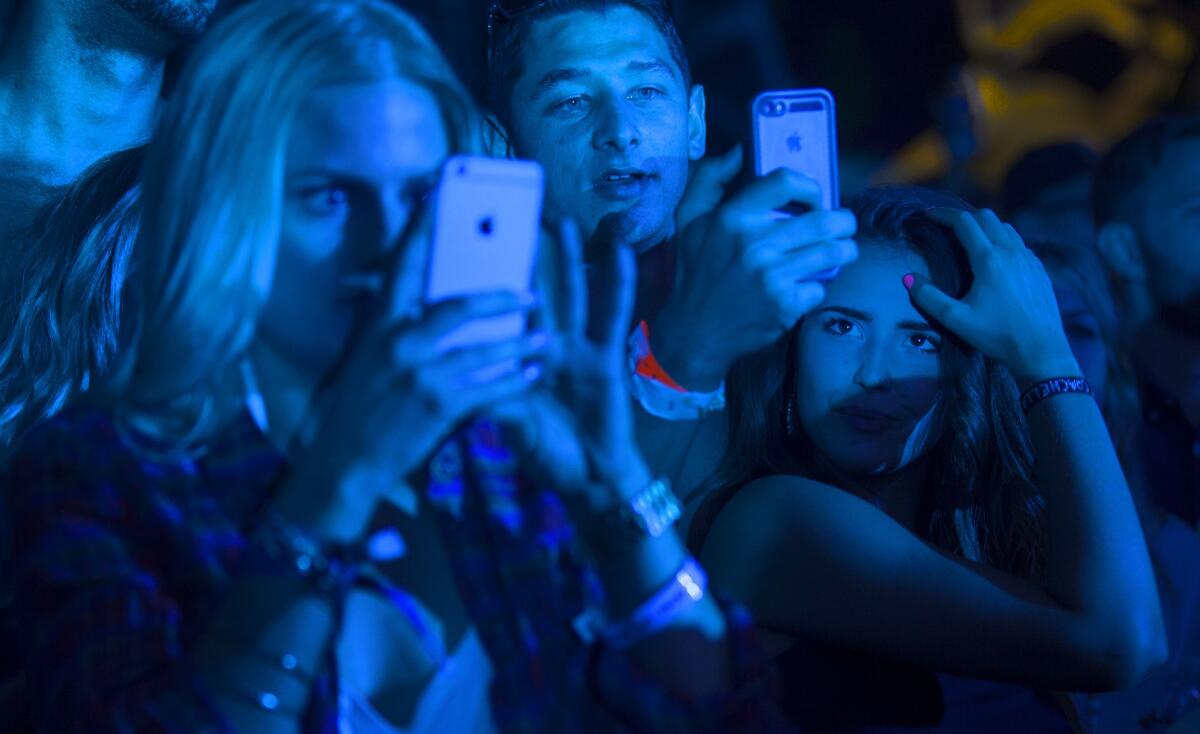Coachella 2015: Digital witnesses and the tyranny of the smartphone

Cellphone cameras are directed at Porter Robinson in the Sahara Tent at the Coachella Valley Music and Arts Festival in Indio, Calif., on Friday.
- Share via
Reporting from Indio, Calif. — On Coachella’s outdoor stage Saturday night, the artist Father John Misty made a noble request, delivered from a place of honesty via a heart-shaped neon sign that hung above him. Within the heart in glowing script read the words, “No Photography.”
Jack White did the same during his headlining set, though his phrasing was a little stronger.
And Sunday night, the guitarist St. Vincent asked the same, using a different tactic: Just before she and her band went onstage, a computerized male voice rang over the PA requesting that fans resist the urge to point and shoot with their digital devices.
FULL COVERAGE: Coachella 2015
In all three instances, a swell of cheers erupted from the crowd.
And in all three instances, the request was met with mixed results. Three or four songs in, the screens started sheepishly rising from the crowd.
Anyone who spent more than five minutes on the Coachella grounds understands how quixotic, but necessary, these requests can be. Fans, especially younger ones, now live and die by their smartphones; asking that they disable them is like requesting they avoid using one of their legs to walk.
Over the course of three days, fans dexterously worked their phones, dotting fingers across glass rectangles like they were playing mini-pianos. Friends shot group selfies. One group played some sort of selfie game, taking photos and then either cheering or booing the results. Fans shot portraits with performers playing in the background. Everybody wanted digital evidence.
The downside to all this digital detritus: no one knew when to stop. Navigating 90,000 people moving every which way toward stages, tents and vendors without any sense of order is tough enough, let alone when most are only halfway paying attention to the journey at hand. The massive pathway from the outdoor stage to the Sahara Tent was packed with thousands of individuals headed different places on different schedules in different states of inebriation and at varied paces.
Here, each step toward your destination was hard won and rife with bodily contact, human pinballs bouncing off human bumpers. Now imagine half of these fans are also looking down at their phones, texting or tweeting, abruptly stopping to take a photo or jogging while eating a plate of nachos and taking a selfie.
The requests from Jack White, St. Vincent and Father John Misty may have been mostly ignored, but the artists backed up their arguments during songs — the latter two artists, at least.
A few tracks into her set, St. Vincent delivered “Digital Witness,” an indictment of social-media obsession. Between masterful guitar bursts, the artist born Annie Clark described the self-absorbed population surrounding her. “Digital witness,” she sang. “What’s the point of even sleeping / If I can’t show it, if you can’t see me? / What’s the point of doing anything?”
Father John Misty (born Josh Tillman) approached the same theme from a different angle in “True Affection.” A protest song about the loss of intimacy in our plugged-in culture, the artist posed a series of melodic requests: “When can we talk with the face instead of using these strange devices?,” he sang, swaying while sarcastically arguing in favor of human conversation. “Wouldn’t be that hard / Get along so well / Sentence by sentence / It’s a trial run / Let me show you how / Figure I can give you true affection.”
While presenting his musical plea, the crowd before him listened attentively. At least most of them. As is the case at Coachella, some weren’t listening at all, and probably never will.
Follow Randall Roberts on Twitter: @liledit
More to Read
The biggest entertainment stories
Get our big stories about Hollywood, film, television, music, arts, culture and more right in your inbox as soon as they publish.
You may occasionally receive promotional content from the Los Angeles Times.











